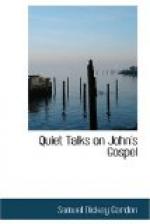And the reason is plain. Jerusalem is Israel. It is the nation. Jesus is wooing the nation through its leaders. Why? For the nation’s sake? for Israel’s sake? Yes and no. Because these Jews were favourites of God? Distinctly no, though so highly favoured they had been in the wondrous mission entrusted to them. But because Israel was the gateway to a world Yes, for Israel’s sake. Through this gateway, so carefully prepared when every other gate was closing, through this out to a world—this was the plan of action. And this will yet be found to be the plan. Through a Jewish gateway the King will one day go out to touch His world. This is the geography of John’s story.
The action of the story swirls largely, too, about the great national feasts, the Passovers, the Tabernacles or harvest-home feast of the autumn, and one called “the Dedication,” not elsewhere spoken of. To these came great crowds of pilgrim Jews from all quarters of the world, speaking many languages beside their national Hebrew, giving large business, especially to money-brokers and traders in the animals and birds used in the sacrifices. That classical Pentecost Chapter of Acts gives the wide range of countries and of languages represented by these pilgrim thousands. These feasts are the central occasions of John’s story.
The time begins with John’s preaching in the Jordan bottoms and reaches up practically to the evening of the betrayal. It is commonly reckoned three and a half years. That is, there are some months before that first Passover, and then the events run through and up to the fourth Passover, reckoning the unnamed feast of chapter five as a Passover. This is the chronology of John’s Gospel. John’s Gospel gives the only clue to the length of Jesus’ ministry.
There are three groups of persons. There are the Jews. That is one of John’s distinctive phrases. By it he means as a rule the official leaders of the nation, whom in common with the other writers he also designates by their party names, Pharisees, Scribes, Chief Priests, and so on. Among these the name of Caiaphas stands out, and later Annas.
Then there are the crowds, the masses of people that flock together in any new stirring movement. There are Galilean crowds, feast-time crowds including the great numbers of foreign pilgrim Jews, city crowds, and country crowds. They gather to John’s preaching. They gather in great numbers in Jerusalem, and on the Galilean visits. They are easily impressionable, swayed by subtle crowd-contagion, stirred up and played upon cunningly by the opposition leaders.
They appeal greatly to Jesus, like unshepherded sheep. And the sick and needy ones, so numerous, draw out His pity and warm touch and healing power. They believe quickly, and almost as quickly are turned away and desert the cause they had so quickly and warmly rallied to. Fickle, unthoughtful, easily-swayed, needy crowds, but with the thoughtful ones and groups here and there who are really helped and who stick. These crowds are always in evidence.




